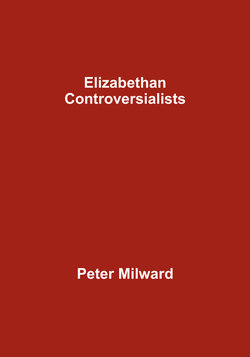Читать книгу Elizabethan Controversialists - Peter Milward - Страница 3
На сайте Литреса книга снята с продажи.
Preface
ОглавлениеSome years ago I published a book entitled Religious Controversies of the Elizabethan Age (London, Scolar Press, 1977), with the sub-title, “A Survey of Printed Sources”. In its pages I dealt with some 630 printed books and pamphlets of religious controversy published mainly during the 45 years of Queen Elizabeth’s reign, giving the title of each in full and linking the titles with each other in a running commentary so as to bring out their logical as well as their chronological order. The titles alone may have served to convey some idea of the contents of the controversies and of the spirit in which the authors approached their respective subjects, but for the time being I explored the contents no further, considering it more than enough, from a bibliographical point of view, to have established their main outline.
Now in this sequel it is my aim to enter into the contents of each major controversy, following a method parallel to that of my former book, replacing the full titles of the books and pamphlets with selected passages culled from them. Thus, whereas the former book was a kind of catalogue of long titles linked together by commentary, this is a kind of anthology with the passages linked together with a minimum of commentary. For it seems to me that first-hand extracts from the controversies, whose contents will inevitably be unfamiliar to the majority of my readers, will be more enlightening than any second-hand narration.
In transcribing these passages I have taken it upon myself to depart from the practice I observed in my former book and to modernize the spelling and punctuation. For it is my aim not so much to delight the eye of the antiquarian or to enlighten the bibliographer as to inform the modern reader and to show him that the religious controversies of the Elizabethan age are not so remote or irrelevant as he may imagine. To my mind nothing is to be gained by preserving a spelling that wasn’t even consistent in its own time, but much is lost by making the contents of these controversies look more old-fashioned than they really are.
In arranging my material, I have retained the headings of the first five chapters of my Religious Controversies of the Elizabethan Age, to which this is, after all, a companion or supplementary volume. But I have refrained from drawing on all the material contained under those headings, preferring to concentrate on three or four major controversialists in each. It has, I submit, to be recognized that controversies are carried on not so much between ideological groups, religious or otherwise, as between human persons, who may represent their group in many respects while also injecting a spirit of their own into the contest of minds. This is precisely what helps to make these controversies so genuinely human in their course and what imparts to each a unique interest of its own. It is indeed to bring out the uniqueness of each controversialist that I have chosen an occasionally odd title for each sub-heading, by characterizing each protagonist with a compound epithet suited to the nature of the controversy in which he plays his part.
I should add that, even more than in my previous book, I have found it difficult to maintain an attitude of consistent impartiality, considering that as a Jesuit priest I am committed to one side in most of these controversies. But at least it may be said that I am not a coldly indifferent but a warmly interested observer. Here I may repeat what I stated in the Preface of my former book, that “however much these authors may have been at loggerheads with each other, I have learnt to feel sympathy with their respective viewpoints, however much they may differ (in formal statement) from my own Catholic viewpoint.” I even feel warmly disposed to poor William Watson, whom I have chosen to represent the Appellant priests, as he was also chosen by them. Not that I can agree with his bare-faced exaggerations and wicked calumnies against the Jesuits, any more than his opponent Father Persons did, but I can’t help admiring, more than his opponent did, the style of his sentences, even if their euphuism often carries him beyond the bounds of truth and justice.
Finally, I would emphasize that for me the main point of this book is to be found in the appendix. It is a truth all too often forgotten, not least by Shakespeare scholars, that this was an age as well of intense religious controversy as of the vigorous secular drama. On the surface, the respective series of religious (or irreligious) books and secular plays may seem to have little to do with each other, and so the specialists on either side tend to ignore the other. But the deeper we explore their contents, the more variety and width we discover in their interconnections. In not a few of the books and pamphlets, such as Watson’s Quodlibets, there are interesting allusions to the drama of the time, and in not a few of the plays, particularly those of Shakespeare, there are echoes of significant words and phrases characteristic of the controversies. In my brief conclusion I have merely touched on a few of them as a kind of supplement to my books on the dramatist from Shakespeare’s Religious Background (London, Sidgwick & Jackson, 1973) to Shakespeare the Papist (Florida, Sapientia Press, 2005).
Bibliographical Note
At the end of each chapter I have appended a Bibliographical Note, indicating the titles of the books under consideration, together with the number of the corresponding entry in my Religious Controversies of the Elizabethan Age (abbreviated as RC).
